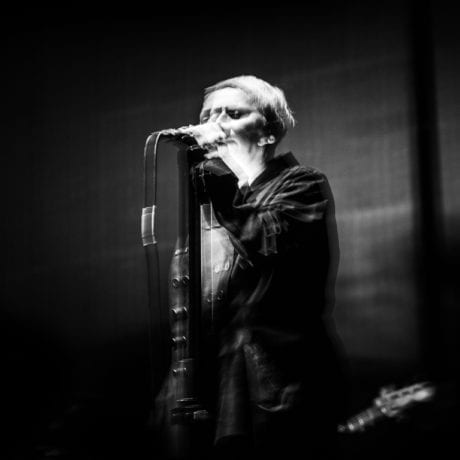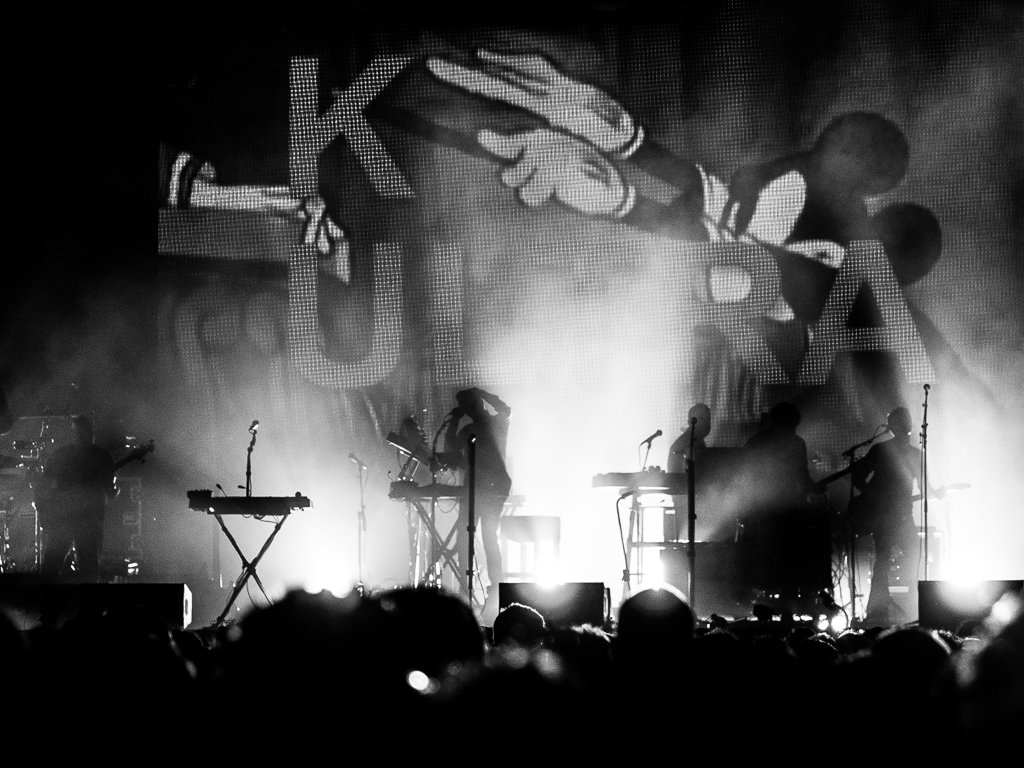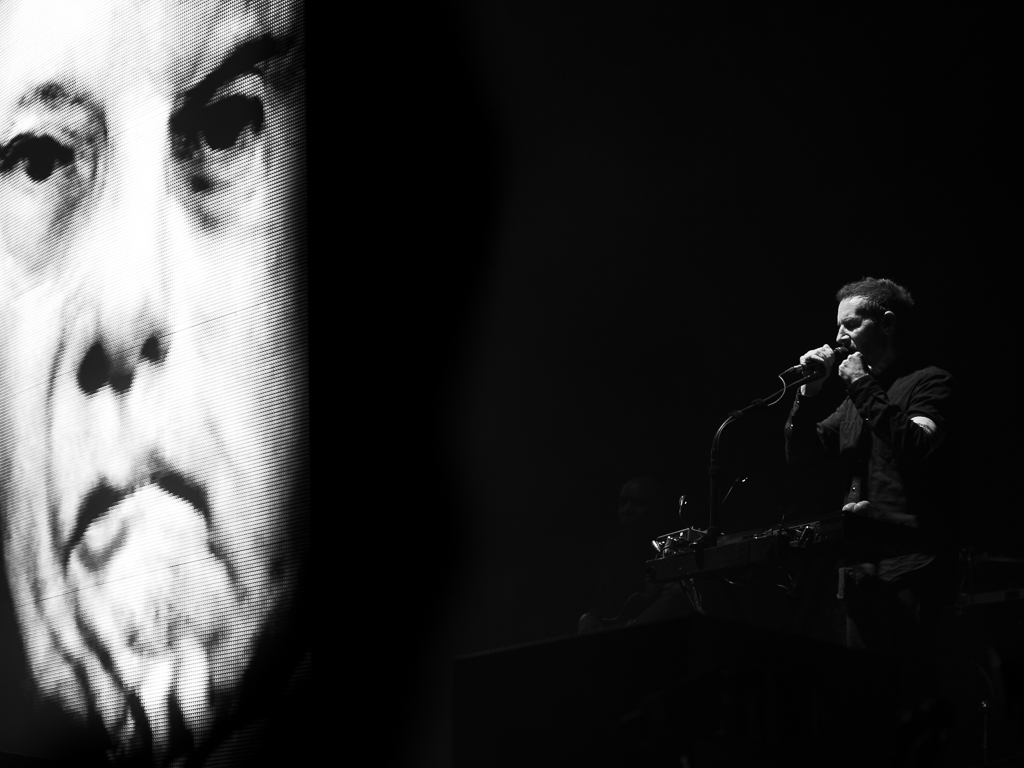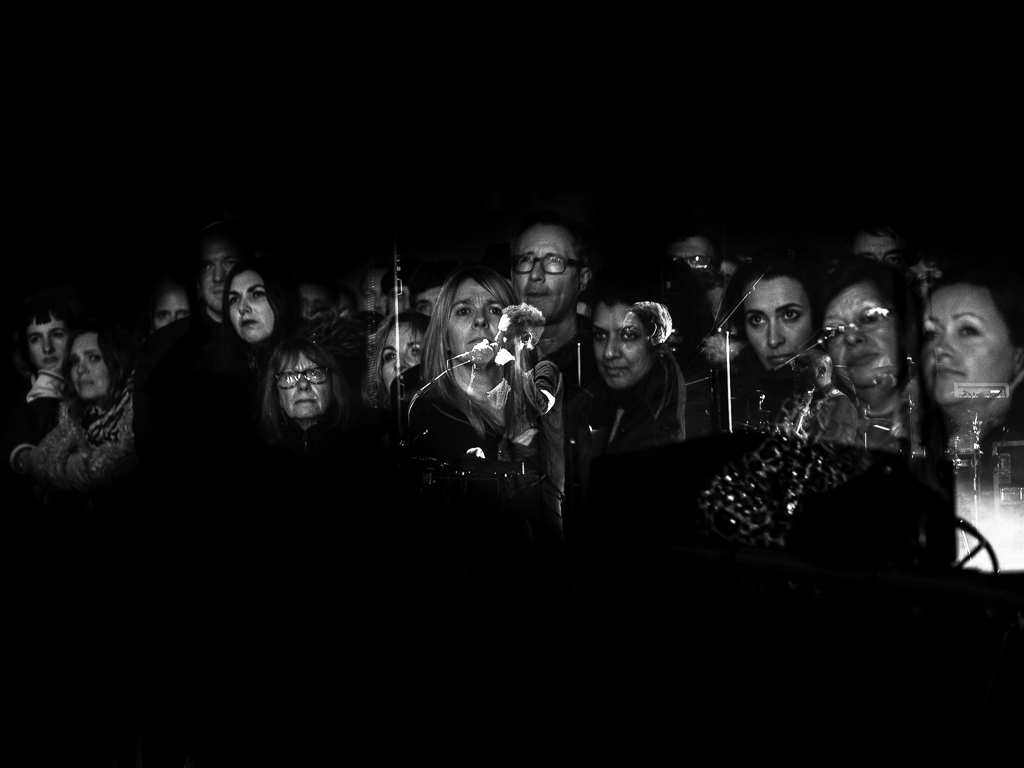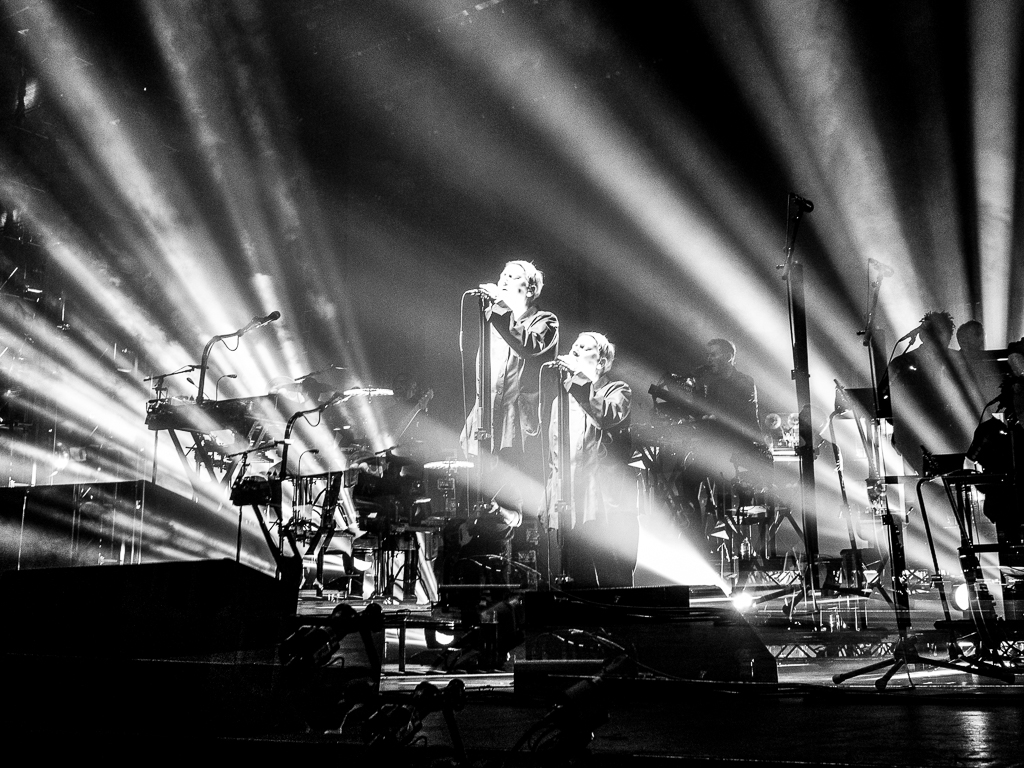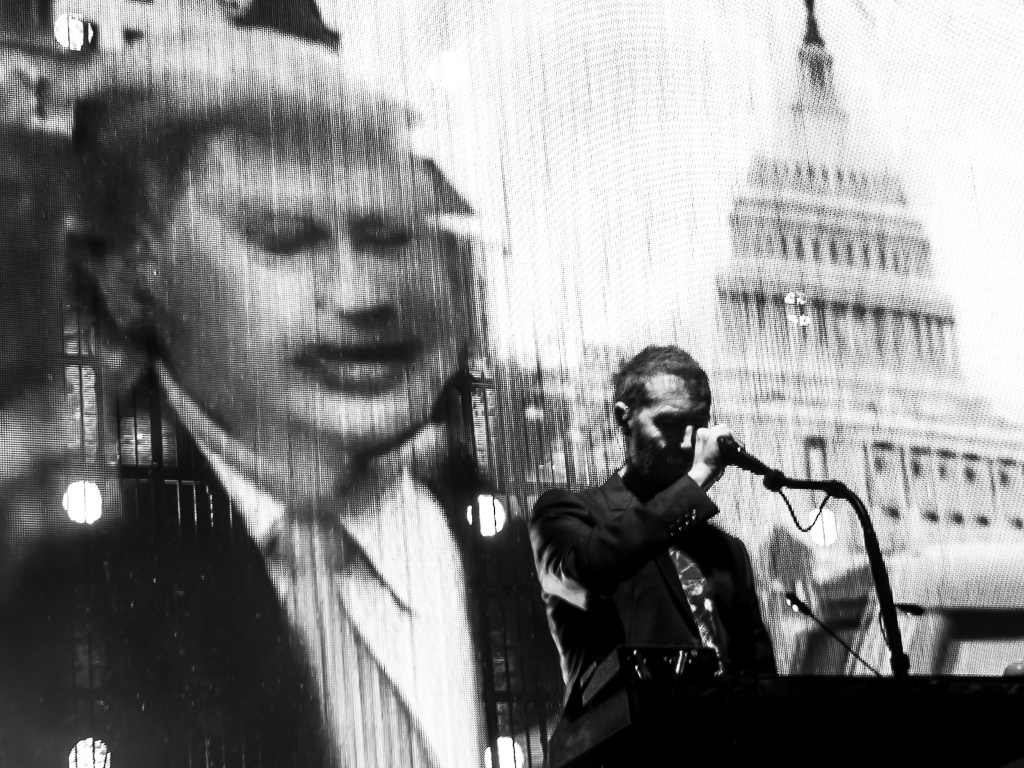
Massive Attack’s Mezzanine remains an extraordinary album: a work of suspense and brooding soul that envelopes you entirely. For the London show marking its twenty-first anniversary—the second time that the Bristol outfit have collaborated with doc filmmaker Adam Curtis (Bitter Lake; HyperNormalisation)—the group somehow make the vast O2 venue feel incredibly intimate.
There’s an unexpected jolt when the show starts not with the deep, dub-laced rumble of album opener Angel, but a full band take on the Velvet Underground’s I Found A Reason—which Massive Attack spliced into their own, shiver-inducing Risingson with mainmen Robert “3D” Del Naja and Grant “Daddy G” Marshall resuming their persuasively raspy, conspiratorial lead vocals. But the band have never been given to basic nostalgia: in Mezzanine XXI, it feels like we’re looking inwards, rather than backwards. The setlist intersperses the album’s original intoxicating tracks with cover versions of the far-ranging numbers that provide samples and connective material for Mezzanine; spanning Bauhaus to the Cure and late EDM artist Avicii.
“I told the promoters that there was going to be no Hollywood ending”
All of Mezzanine’s material is here, along with phenomenal guest vocalists Elizabeth Fraser of Cocteau Twins (an ultra-rare performance) and Jamaican roots reggae songwriter and singer Horace Andy, making the experience somehow both unmistakeable and unpredictable. Giant screens and digital columns on either side of the stage transmit Curtis’s immaculately spliced visuals: side-eye views of pop culture and political spectres (the London crowds jeer at images of Donald Trump, then cheer excitedly for Judy Garland as Dorothy in The Wizard Of Oz), off-kilter slogans, and an overriding sense of wonder and dread. It also frequently evokes the consumer meltdowns of Jenny Holzer’s Protect Me from What I Want…
“I told the promoters that there was going to be no Hollywood ending,” laughs Del Naja when we catch up after the show. He admits that the 2013 Manchester International Festival collaboration with Curtis left him with “a feeling of slight disjointedness”: Del Naja always comes across as both sweet-natured and a creatively restless soul, fascinated by tech yet committed to humanity, across his music and visual art projects.
“We put so much into the [MIF] production; it’s one of the most complex things I’ve ever worked on, but we could only present it to a select number of people,” says Del Naja. “We were playing songs that we wouldn’t normally play, and what was interesting was the discomfort of putting it on, as well as the challenge; it was a really powerful feeling.”
The concept of revisiting Mezzanine in the twenty-first century, and extending that creative rapport with Curtis, felt like a natural progression. “Adam and I both work in collages; Massive Attack used music, rather than images,” adds Del Naja. “The idea I wanted to convey in this show was a mirror to where we are now. Examining where we are culturally, through the medium of a gig, trying to create moments where things felt harmonious, and where it would jar. I took the approach where we’d “extract” the tracks that were sampled for
Mezzanine, and Adam was interested in making films that explore the nature of meaning and history.
“We had this shared desire to do something really disorientating, but it also had to have feeling and soul. Adam has access to a massive archive which he uses to build these amazing, informative, beautiful pieces of art, which tell you about the world you think you know. I love the way he tells stories about people, as well as the brilliant social and political analysis. His films remind me of the ghosts of the songs we write.”
He continues: “A lot of this has been about the reliability of information—how it’s distributed, in what direction. Can we move forward if our behaviour is dictated by algorithms—predictive technology designed to influence the future?”
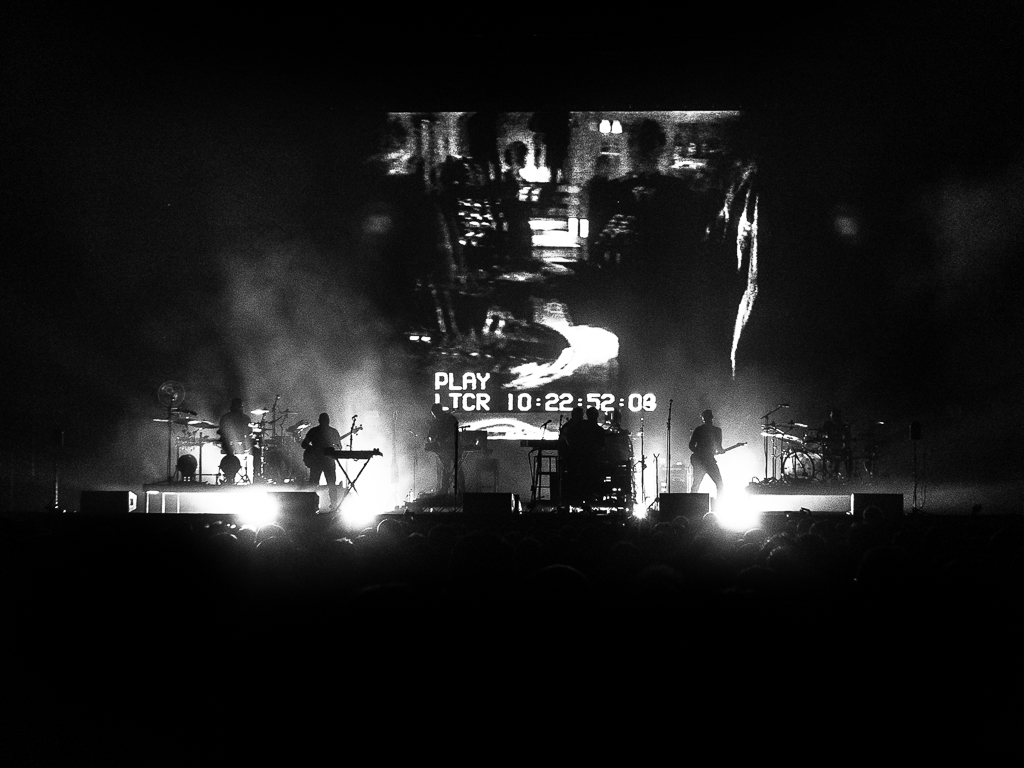
The tech theme has long struck a chord with Curtis, too, as shown in his 2011 series All Watched Over By Machines of Loving Grace. His boldly hypnotic visual style is often mimicked and sometimes mocked, yet it’s also fantastically intricate and surprisingly emotive. In Mezzanine XXI, it feels like a series of shocks to the system: we’re lulled by celebrity faces and statements of conviction (the screens glare, “If you liked that, then you will love this”), and left reeling by brutal contrasts. There’s also an incredible synchronicity to the strangest images, a YouTube mash-up of fan tributes; a folk dance; a military two-step.
“Can we move forward if our behaviour is dictated by algorithms—predictive technology designed to influence the future?”
Massive Attack’s live tours have always displayed a politically conscious core. For previous tours, Del Naja created memorable collaborations with London’s United Visual Artists, highlighting issues including refugee experience or the covert horror of “extraordinary rendition” [US
government-sponsored abduction and extrajudicial transfer of a person from one country to another]. When Massive Attack curated the Meltdown Festival at London’s Southbank Centre in 2008, the venue was emblazoned with Del Naja’s designs for flags of imaginary nations (he’s since created digital versions). The themes of democracy, affinity and territory also resonate throughout the Mezzanine XXI live show, not least in an onscreen sequence of global political slogans as Horace Andy croons sweetly.
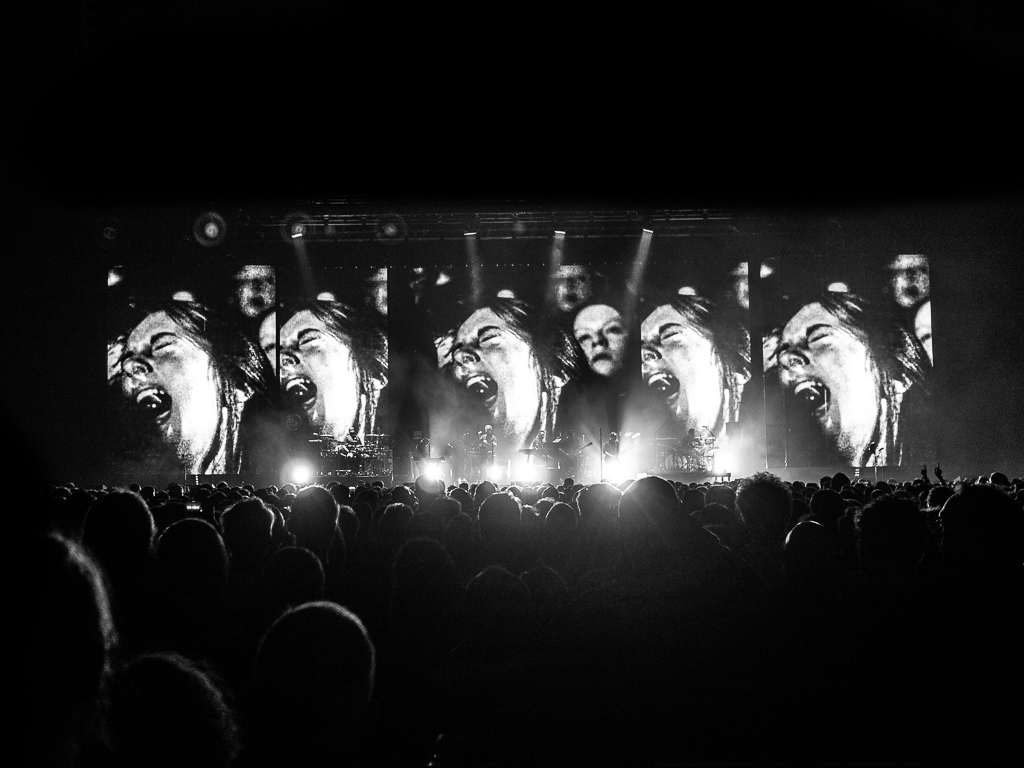
Mezzanine proved to be a distinctly different beast upon its original 1998 release. Its darker, harsher tones set it apart from the music around it, and even Massive Attack’s earlier catalogue. It was visionary in its sound, its visual style (Nick Knight’s cover art utilized breakthrough cut-and-paste techniques) and its technology—it was the first album ever to be released as a free online stream.
“We came from Bristol at a time when dance music was always at the forefront of innovation and technology. By the time we got to Mezzanine, the Internet had grown around us”
Mezzanine XXI pushes the cutting-edge further; Massive Attack worked with a Zurich-based science lab to have the album encoded into synthetic DNA strands, and stored in spraycan form. “It became an opportunity to analyse it in a grand, transformative way, that also looked at the environmental impact of data storage,” says Del Naja. “We came from Bristol at a time when dance music was always at the forefront of innovation and technology. By the time we got to Mezzanine, the Internet had grown around us.”
For Mezzanine XXI, as Del Naja says, there is “no Hollywood ending”, but its haunting melodies and hyperreal images do evoke an inspirational endnote. “This show is about how the mind works, and how nostalgia works, and collective meaning—and I think it does have a message of unity,” Del Naja insists. “It questions what we’re fighting against.”
